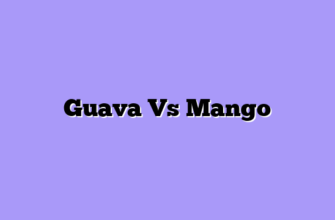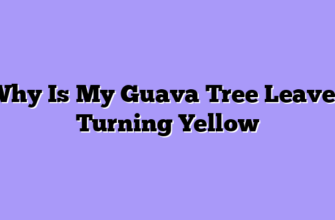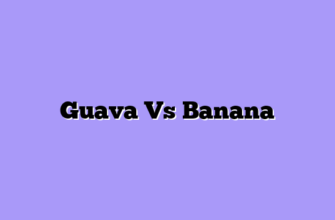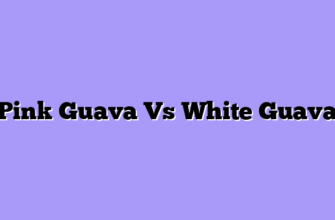Guava trees, known for their delicious and nutritious fruit, require proper fertilization to thrive and produce bountiful harvests. Choosing the right fertilizer is crucial for ensuring optimal growth, fruit production, and overall health of your guava tree. Understanding the nutritional needs of guava trees and the different types of fertilizers available will help you make an informed decision.
Choosing the Right Fertilizer for Your Guava Tree
Guava trees, like most fruit trees, require a balanced diet of essential nutrients, including nitrogen, phosphorus, and potassium. Nitrogen promotes healthy foliage and vigorous growth, while phosphorus plays a vital role in root development and flower production. Potassium contributes to disease resistance and overall plant vigor. Additionally, guava trees benefit from micronutrients such as calcium, magnesium, and zinc, which are essential for various physiological processes.
When selecting a fertilizer for your guava tree, consider the age and stage of growth. Young, actively growing trees require a higher nitrogen content to support rapid growth. As the tree matures and enters the fruiting stage, the focus shifts to phosphorus and potassium, which promote flower and fruit development.

Organic fertilizers, such as compost, manure, and bone meal, are a sustainable and environmentally friendly option. They improve soil structure, enhance water retention, and provide a slow-release source of nutrients. However, organic fertilizers may not provide all the essential nutrients in the required amounts, and their effectiveness can vary depending on the quality and composition.
To determine the specific fertilizer needs of your guava tree, it is advisable to conduct a soil test. This will provide valuable information about the nutrient content of your soil and identify any deficiencies that need to be addressed. Based on the soil test results, you can choose a fertilizer that provides the appropriate balance of nutrients for your guava tree.
In addition to fertilizer application, other factors that influence the health and productivity of guava trees include proper watering, pruning, and pest and disease management. By providing your guava tree with the right care and nutrition, you can enjoy a bountiful harvest of delicious and nutritious fruit for years to come.
Understanding the Nutritional Needs of Guava Trees
- Macronutrients play a vital role in various aspects of plant growth. Nitrogen, a key component of chlorophyll, is essential for photosynthesis, the process by which plants convert sunlight into energy. Phosphorus is crucial for root development, flower formation, and fruit production. Potassium, another essential macronutrient, aids in water regulation, disease resistance, and overall plant vigor.
- Micronutrients, while required in smaller amounts, are equally important for the health of guava trees. Iron, for instance, is involved in chlorophyll production and helps prevent chlorosis, a condition characterized by yellowing leaves. Manganese is essential for photosynthesis and respiration, while zinc plays a role in enzyme activity and growth regulation. Boron, another micronutrient, is crucial for cell wall formation and fruit development.
- The specific nutrient requirements of guava trees can vary depending on factors such as soil type, climate, and the age of the tree. However, a balanced fertilizer program that provides a consistent supply of essential nutrients is crucial for optimal growth and fruit production.
- Fertilizers can be applied in various forms, including granular, liquid, and organic. Granular fertilizers are typically applied to the soil around the base of the tree, while liquid fertilizers can be applied directly to the leaves or through the irrigation system. Organic fertilizers, such as compost and manure, provide a slow-release source of nutrients and improve soil structure.
- When choosing a fertilizer for guava trees, it is important to consider the specific nutrient ratios and the overall composition of the fertilizer. A balanced fertilizer that contains a mix of macronutrients and micronutrients is generally recommended. It is also important to follow the manufacturer’s instructions for application rates and timing.
Regular soil testing can help determine the specific nutrient deficiencies in the soil and guide fertilizer application. By understanding the nutritional needs of guava trees and implementing a balanced fertilizer program, growers can ensure healthy growth, abundant fruit production, and a thriving orchard.
Organic Fertilizer Options for Guava Trees
Compost, a rich and readily available organic fertilizer, is an excellent choice for guava trees. It is created by decomposing organic matter, such as kitchen scraps, yard waste, and leaves. Compost improves soil structure, aeration, and water retention, creating an ideal environment for root development. Moreover, it provides a balanced supply of essential nutrients, including nitrogen, phosphorus, and potassium, which are crucial for guava tree growth and fruit production.
Manure, another valuable organic fertilizer, is a natural source of nutrients and beneficial microorganisms. Animal manure, such as cow, horse, or chicken manure, is rich in nitrogen, phosphorus, and potassium, as well as other trace elements. However, it is important to use manure that has been properly composted to reduce the risk of introducing pathogens or weed seeds into the soil.
Plant-based fertilizers, such as bone meal, blood meal, and fish emulsion, offer specific nutrient benefits. Bone meal is a good source of phosphorus, which is essential for root development and flower production. Blood meal is rich in nitrogen, promoting healthy leaf growth. Fish emulsion, derived from processed fish, provides a balanced supply of nutrients and beneficial microorganisms.
When applying organic fertilizers to guava trees, it is crucial to follow the recommended guidelines. Over-fertilizing can lead to nutrient imbalances and damage to the tree. It is best to apply a thin layer of fertilizer around the base of the tree, avoiding direct contact with the trunk. The frequency of application depends on the type of fertilizer and the specific needs of the tree.
In addition to organic fertilizers, other practices can enhance the health and productivity of guava trees. Mulching around the base of the tree helps retain moisture, suppress weeds, and improve soil fertility. Regular pruning encourages healthy growth and fruit production. Providing adequate sunlight and water is also essential for optimal growth.
How to Apply Fertilizer to Guava Trees
Guava trees, like most fruit trees, benefit from a balanced diet of essential nutrients. These include nitrogen, phosphorus, potassium, calcium, magnesium, and micronutrients like iron, zinc, and manganese. Nitrogen promotes vigorous leaf growth and overall plant health. Phosphorus plays a vital role in root development and flower production. Potassium aids in fruit development and disease resistance. Calcium strengthens cell walls and prevents blossom end rot. Magnesium is essential for chlorophyll production, while micronutrients contribute to various metabolic processes.
The best time to fertilize guava trees is during the early spring, just before new growth emerges. This allows the tree to utilize the nutrients effectively for optimal growth and fruit production. However, depending on the specific needs of the tree and the soil conditions, additional fertilization may be required throughout the growing season.
When applying fertilizer, it’s important to choose a product specifically formulated for fruit trees. These fertilizers typically contain a balanced ratio of nutrients tailored to the needs of fruit-bearing plants. Avoid using fertilizers high in nitrogen, as this can promote excessive leaf growth at the expense of fruit production.
There are several methods for applying fertilizer to guava trees. One common method is to apply granular fertilizer around the base of the tree, creating a ring about 1-2 feet away from the trunk. This allows the nutrients to gradually penetrate the soil and reach the roots. Another method is to use liquid fertilizer, which can be applied directly to the soil or through a drip irrigation system.
When applying fertilizer, it’s crucial to follow the manufacturer’s instructions carefully. Over-fertilizing can be detrimental to the tree, leading to nutrient imbalances and potential damage to the roots. It’s also important to avoid applying fertilizer directly to the trunk, as this can cause bark damage.
In addition to regular fertilization, it’s essential to monitor the health of the guava tree and adjust the fertilization program accordingly. Signs of nutrient deficiency, such as yellowing leaves, stunted growth, or poor fruit production, indicate the need for additional fertilization. Soil testing can provide valuable insights into the nutrient content of the soil and help determine the specific nutrients that need to be supplemented.
By understanding the nutritional needs of guava trees and applying fertilizer effectively, you can ensure their optimal growth, fruit production, and overall health. Remember to choose a balanced fertilizer, apply it at the appropriate time and rate, and monitor the tree’s health for any signs of nutrient deficiency. With proper fertilization, your guava tree will reward you with delicious and abundant fruit for years to come.
Signs of Fertilizer Deficiency in Guava Trees
One of the most noticeable signs of fertilizer deficiency in guava trees is stunted growth. If the tree is not growing at a healthy rate, it may indicate a lack of essential nutrients like nitrogen, phosphorus, or potassium. These nutrients are vital for cell division and elongation, which are crucial for the tree’s overall growth. A stunted guava tree may also have smaller leaves and thinner branches, further indicating a nutrient deficiency.
Another telltale sign is the presence of yellowing leaves, known as chlorosis. This condition arises from a lack of chlorophyll, the pigment responsible for photosynthesis. Chlorophyll production requires magnesium, iron, and nitrogen, and their deficiency can lead to yellowing leaves. The severity of chlorosis can vary depending on the specific nutrient deficiency. For instance, a lack of nitrogen often results in a uniform yellowing of the leaves, while iron deficiency may cause yellowing between the veins, leaving the veins themselves green.
Furthermore, the appearance of the leaves can also provide clues about nutrient deficiencies. For example, a deficiency in phosphorus can cause the leaves to turn a dark green color and develop a purplish hue, particularly on the underside. Additionally, a lack of potassium can lead to leaf margins turning brown and crispy, eventually leading to leaf drop.
Beyond the leaves, the fruit itself can also exhibit signs of nutrient deficiency. Guava trees with insufficient nutrients may produce smaller, less flavorful fruits. The fruit may also ripen unevenly or develop blemishes, indicating a lack of essential nutrients during the fruiting stage.
Recognizing these signs of fertilizer deficiency is essential for timely intervention. By understanding the specific nutrient deficiencies, you can address them with appropriate fertilizers. For instance, if the tree exhibits signs of nitrogen deficiency, applying nitrogen-rich fertilizers can help restore its growth and vigor. Similarly, if the leaves are yellowing due to iron deficiency, applying iron chelates can help correct the deficiency.
Regular soil testing is crucial for determining the specific nutrient levels in the soil and identifying any deficiencies. Based on the test results, you can tailor a fertilization program to meet the specific needs of your guava tree. By providing the necessary nutrients, you can ensure the tree’s health, promote vigorous growth, and maximize fruit production. Remember, a healthy guava tree is a happy tree, yielding delicious and nutritious fruit for you to enjoy.
Q&A
**1. What type of fertilizer is best for guava trees?**
**Answer:** Guava trees benefit from a balanced fertilizer with a higher nitrogen content for foliage growth, followed by phosphorus for root development and flowering, and potassium for fruit production.
**2. When should I fertilize my guava tree?**
**Answer:** Fertilize your guava tree during the growing season, typically from spring to early fall. Avoid fertilizing during the winter months when the tree is dormant.
**3. How much fertilizer should I use?**
**Answer:** The amount of fertilizer depends on the age and size of the tree. Young trees require less fertilizer than mature trees. Follow the instructions on the fertilizer packaging for specific recommendations.
**4. How often should I fertilize my guava tree?**
**Answer:** Fertilize your guava tree every 4-6 weeks during the growing season. You can reduce the frequency to once every 8-10 weeks during the cooler months.
**5. What are some signs of nutrient deficiency in a guava tree?**
**Answer:** Signs of nutrient deficiency include stunted growth, yellowing leaves, weak stems, and reduced fruit production. If you notice any of these symptoms, consider adjusting your fertilization program.








